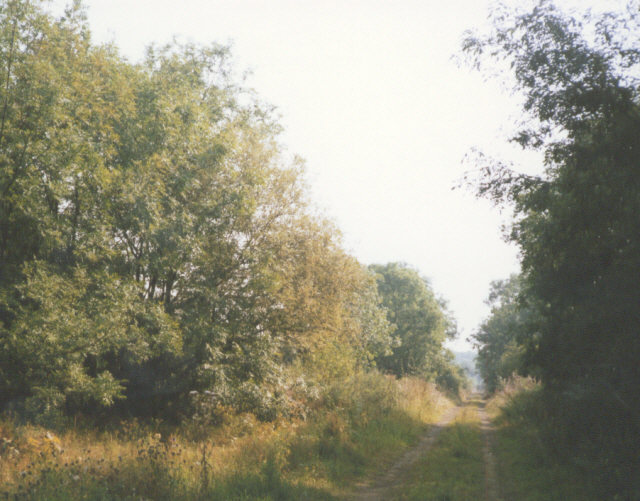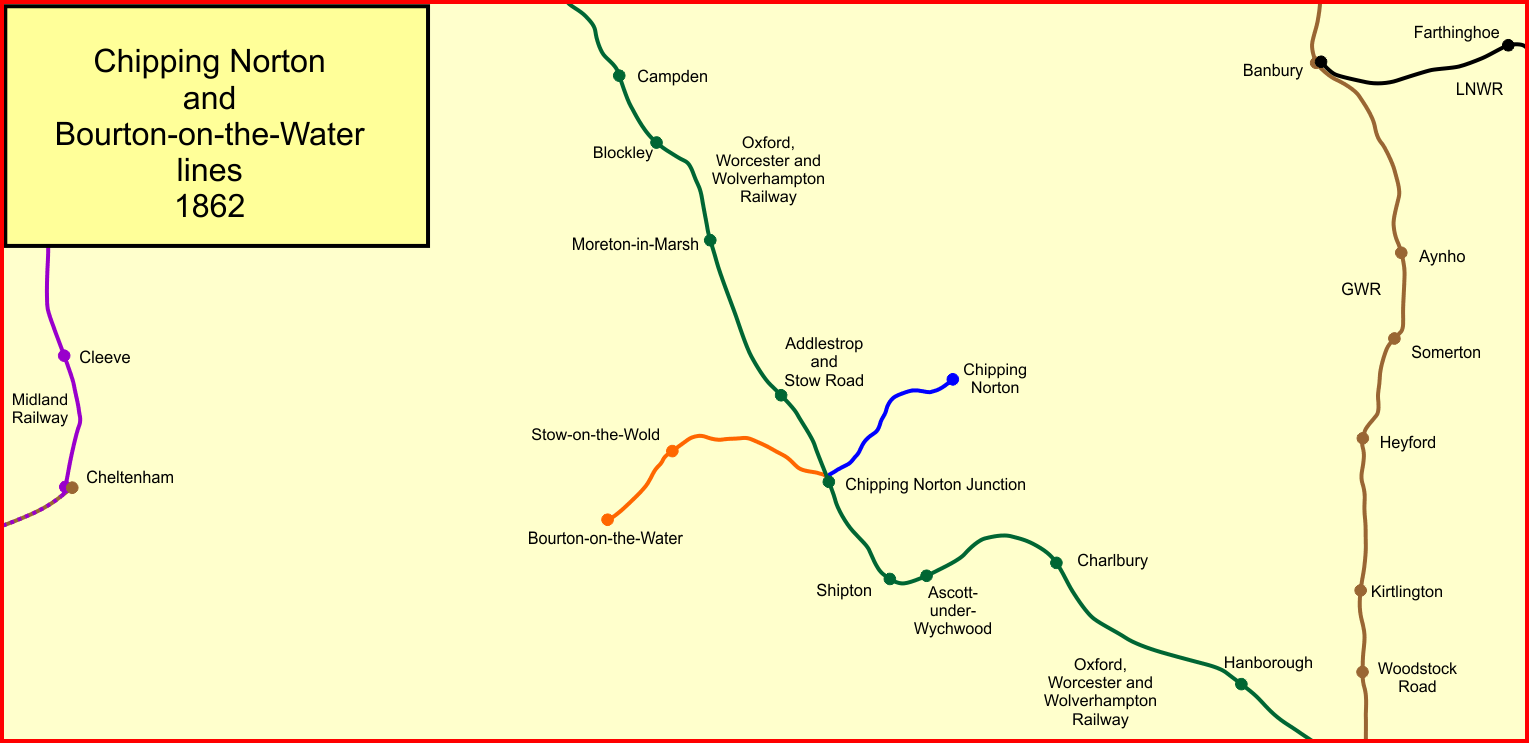|
Milton Halt Railway Station
Milton Halt railway station is a former railway station that served the village of Milton in northern Oxfordshire, England. History The station was built by the Great Western Railway. It opened to passengers on 1 January 1908 (Jenkins gives the date as 1 January 1906 but the Board of Trade plan on the same page is dated 14 November 1907 suggesting that the 1908 date given by other sources is correct). The Halt had a wooden platform and "pagoda" shelter. There was also a small corrugated iron shed, identified as "office" on the 1907 Board of Trade plan, with the area between the two buildings identified as "space for milk churns". Although no goods facilities were provided, milk traffic was important and as soon as the halt opened two farmers paid £5 a year each for milk carriage. Hemmings Vol.1, p.158. The halt was located on an embankment and approached by a cinder path from the road below. It was unstaffed and the guards of the first and last trains of the day would ligh ... [...More Info...] [...Related Items...] OR: [Wikipedia] [Google] [Baidu] |
Milton Halt Railway Station
Milton Halt railway station is a former railway station that served the village of Milton in northern Oxfordshire, England. History The station was built by the Great Western Railway. It opened to passengers on 1 January 1908 (Jenkins gives the date as 1 January 1906 but the Board of Trade plan on the same page is dated 14 November 1907 suggesting that the 1908 date given by other sources is correct). The Halt had a wooden platform and "pagoda" shelter. There was also a small corrugated iron shed, identified as "office" on the 1907 Board of Trade plan, with the area between the two buildings identified as "space for milk churns". Although no goods facilities were provided, milk traffic was important and as soon as the halt opened two farmers paid £5 a year each for milk carriage. Hemmings Vol.1, p.158. The halt was located on an embankment and approached by a cinder path from the road below. It was unstaffed and the guards of the first and last trains of the day would ligh ... [...More Info...] [...Related Items...] OR: [Wikipedia] [Google] [Baidu] |
Transport Act 1947
The Transport Act 1947 (10 & 11 Geo. 6 c. 49) was an Act of the Parliament of the United Kingdom. Under the terms of the Act, the railway network, long-distance road haulage and various other types of transport were nationalised and came under the administration of the British Transport Commission. The BTC was responsible to the Ministry of Transport for general transport policy, which it exercised principally through financial control of a number of executives set up to manage specified sections of the industry under schemes of delegation. Overview The Act was part of the nationalisation agenda of Clement Attlee's Labour government, and took effect from 1 January 1948. In Northern Ireland, the Ulster Transport Authority acted in a similar manner. The government also nationalised other means of transport such as: canals, sea and shipping ports, bus companies, and eventually, in the face of much opposition, road haulage. All of these transport modes, including British Railways, ... [...More Info...] [...Related Items...] OR: [Wikipedia] [Google] [Baidu] |
Railway Stations In Great Britain Opened In 1908
Rail transport (also known as train transport) is a means of transport that transfers passengers and goods on wheeled vehicles running on rails, which are incorporated in tracks. In contrast to road transport, where the vehicles run on a prepared flat surface, rail vehicles (rolling stock) are directionally guided by the tracks on which they run. Tracks usually consist of steel rails, installed on sleepers (ties) set in ballast, on which the rolling stock, usually fitted with metal wheels, moves. Other variations are also possible, such as "slab track", in which the rails are fastened to a concrete foundation resting on a prepared subsurface. Rolling stock in a rail transport system generally encounters lower frictional resistance than rubber-tyred road vehicles, so passenger and freight cars (carriages and wagons) can be coupled into longer trains. The operation is carried out by a railway company, providing transport between train stations or freight customer facilit ... [...More Info...] [...Related Items...] OR: [Wikipedia] [Google] [Baidu] |
Former Great Western Railway Stations
A former is an object, such as a template, gauge or cutting die, which is used to form something such as a boat's hull. Typically, a former gives shape to a structure that may have complex curvature. A former may become an integral part of the finished structure, as in an aircraft fuselage, or it may be removable, being using in the construction process and then discarded or re-used. Aircraft formers Formers are used in the construction of aircraft fuselage, of which a typical fuselage has a series from the nose to the empennage, typically perpendicular to the longitudinal axis of the aircraft. The primary purpose of formers is to establish the shape of the fuselage and reduce the column length of stringers to prevent instability. Formers are typically attached to longerons, which support the skin of the aircraft. The "former-and-longeron" technique (also called stations and stringers) was adopted from boat construction, and was typical of light aircraft built until the a ... [...More Info...] [...Related Items...] OR: [Wikipedia] [Google] [Baidu] |
Banbury And Cheltenham Direct Railway
The Banbury and Cheltenham Direct Railway (B&CDR) was a railway company through the Cotswolds in England that built a line between points near Banbury and Cheltenham. Its principal objective, as well as a general rural rail service, was the conveyance of iron ore from the East Midlands to South Wales. It extended two pre-existing branches, the branch of the Oxford, Worcester and Wolverhampton Railway (OW&WR, opened in 1855) and the Railway (opened in 1862). Both branches had their main line junction at Chipping Norton Junction, later renamed , on the OW&WR main line. The B&CDR opened its western section, from Bourton-on-the-Water to a junction near Cheltenham, in 1881, and its eastern section, from Chipping Norton to a junction at , near Banbury, in 1887. The company was always short of money, and the timescale of construction was correspondingly lengthy. When the extensions opened, the Great Western Railway worked the B&CDR line and the two earlier branches as a single railway ... [...More Info...] [...Related Items...] OR: [Wikipedia] [Google] [Baidu] |
Bloxham Railway Station
Bloxham railway station served the village of Bloxham in northern Oxfordshire, England. History The station was built by the Banbury and Cheltenham Direct Railway, which was taken over by the Great Western Railway before its opening. The station had two platforms, a passing loop and a signal box of Gloucester Wagon Company design. There was a goods shed and two-siding goods yard. In 1907 signalling changes were made utilising re-assembled equipment originally from Bays Hill, Cheltenham. Hemmings states that a new signal box was provided in this year, Jenkins dates the box to 1890-5 and suggests that only the frame and locking were installed in 1907. The station acquired fame in the 1920s for its extensive gardens which included ''“Lawns, paths and treillage, rose borders and rock gardens”''. The gardens were the creation of the Station Master, Herbert Lloyd, and regularly won the GWR Worcester Division garden competition. By 1938 passenger numbers were small with an a ... [...More Info...] [...Related Items...] OR: [Wikipedia] [Google] [Baidu] |
Adderbury Railway Station
Adderbury railway station served the village of Adderbury in Oxfordshire, England. History The station was built by the Banbury and Cheltenham Direct Railway, which was taken over by the Great Western Railway before its opening. When Britain's railways were nationalised in 1948 the B&CDR became part of the Western Region of British Railways The Western Region was a region of British Railways from 1948. The region ceased to be an operating unit in its own right on completion of the "Organising for Quality" initiative on 6 April 1992. The Region consisted principally of ex- Great ..., which then withdraw passenger services through Adderbury in 1951. Line through the station closed completely in 1969. A housing estate has now been built on the station site and no trace of the railway remains. Route References * * * Station on navigable O.S. map {{Closed stations Oxfordshire Disused railway stations in Oxfordshire Former Great Western Railway stations R ... [...More Info...] [...Related Items...] OR: [Wikipedia] [Google] [Baidu] |
Milton, Cherwell
Milton is a village and civil parish about south of Banbury in Oxfordshire, on the Milton road between the villages of Adderbury and Bloxham. *The Church of England parish church of Saint John the Evangelist was built in 1856 by the Gothic Revival architect William Butterfield. *Milton has one public house, The Marlstone Tavern, aka the pie pub, https://piepub.co.uk/ The public house has a carpark, garden and is a Freehouse. *The former Banbury and Cheltenham Direct Railway, part of the Great Western Railway, was completed in 1881. The GWR opened a small railway station, Milton Halt, in 1908 on the northern edge of the village near Manor Farm. British Railways closed the halt in 1951 and closed the railway to freight traffic in 1964. The track was removed in 1965. *The village is built near an affluent of the River Cherwell The River Cherwell ( or ) is a tributary of the River Thames in central England. It rises near Hellidon, Northamptonshire and flows southwards fo ... [...More Info...] [...Related Items...] OR: [Wikipedia] [Google] [Baidu] |
England
England is a country that is part of the United Kingdom. It shares land borders with Wales to its west and Scotland to its north. The Irish Sea lies northwest and the Celtic Sea to the southwest. It is separated from continental Europe by the North Sea to the east and the English Channel to the south. The country covers five-eighths of the island of Great Britain, which lies in the North Atlantic, and includes over 100 smaller islands, such as the Isles of Scilly and the Isle of Wight. The area now called England was first inhabited by modern humans during the Upper Paleolithic period, but takes its name from the Angles, a Germanic tribe deriving its name from the Anglia peninsula, who settled during the 5th and 6th centuries. England became a unified state in the 10th century and has had a significant cultural and legal impact on the wider world since the Age of Discovery, which began during the 15th century. The English language, the Anglican Church, and Engli ... [...More Info...] [...Related Items...] OR: [Wikipedia] [Google] [Baidu] |



